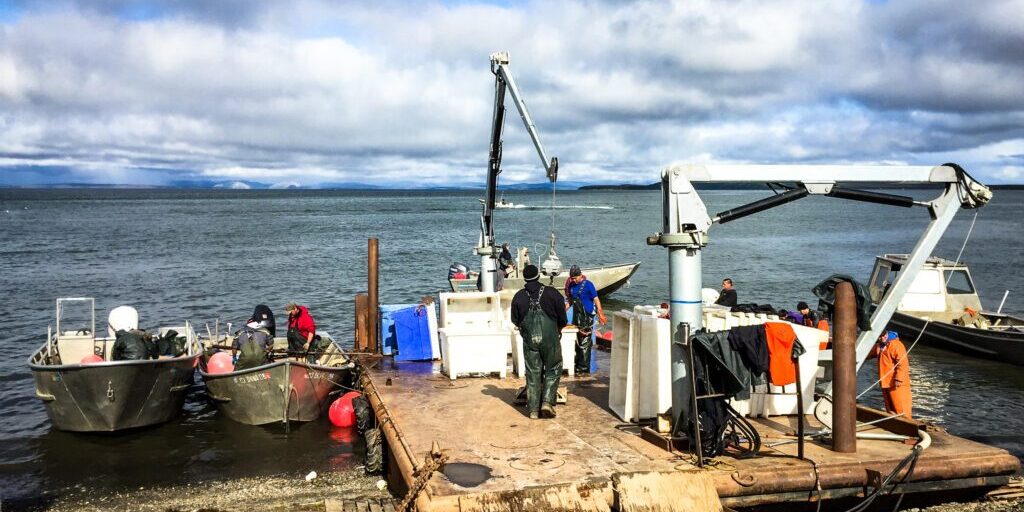Commercial fishing for halibut in the Norton Sound region has barely scratched the surface of the roughly 150,000-pound quota after being open for almost three weeks in the Nome area.
“As far as Nome fishermen, we have six fishermen who have registered, which is in line with what we’ve seen in past years.”
– Tyler Rhodes
Norton Sound Economic Development Corporation’s Chief Operating Officer, Tyler Rhodes, says those six Nome fishermen specifically registered to deliver their halibut to the regional seafood plant this season. And more than one of them has also delivered cod.
The main Nome fisherman catching cod at this point is Phil Pryzmont. Like most local fishers, Pryzmont isn’t going for Norton Sound Red King Crab this summer. Instead, he plans to deliver both cod and halibut.
“Typically halibut gets a lot less interest than crab does. It’s significantly more work and more hours, it’s also later in the season so you’re getting into the bad weather of fall time, September. But the thought is that with no crab season, there may be more people moving into halibut than normal.”
– Phil Pryzmont

As of Monday, roughly 25% out of the total 220,000-pound cod quota has been delivered.
Pryzmont says he’s only been able to deliver up to 10,000 pounds at a time due to Norton Sound Seafood Plant’s limited cod processing abilities. If Pryzmont remains the sole fisher regularly catching cod, it will take him 22 trips at 10,000 pounds each to hit the cod quota. During one recent delivery on July 10th, he caught about half that amount.
On the halibut side of things, Rhodes says Nome fishers were able to begin delivering halibut to NSSP on July 1st. Earlier this month, he told KNOM how the halibut quota was set.
“So this year, our CDQ, our Community Development Quota amount of halibut is 68,940 pounds. On top of that we were able to lease an additional 23,071 pounds of individual fishing quota or IFQ. So that makes a total of just a little bit more than 92,000 pounds that we have available for fishermen.”
– Tyler Rhodes
Since that time, Rhodes has now confirmed that the halibut quota has been increased to 147,000 pounds available for regional fishers. As of Monday, Rhodes said via email that more than 130,000 pounds of that quota is currently available to be caught. That total of 147,000 pounds is split into 31% for Savoonga fishers and 69% for Nome fishers, which equates to 45,573 pounds and 101,438 pounds respectively.
This year the International Pacific Halibut Commission allocated roughly one-million-pounds of halibut for Areas 4D and 4E, which includes the northwestern Bering Sea and Bering Sea flats. Ultimately, the vast majority of the state saw lower catch limits implemented by the IPHC this year compared to 2019.
And according to some fishermen, there’s also been a few alterations to the way NSEDC split up its CDQ for halibut to regional fishers this year.
“Well I’m pretty nervous about the halibut season. We’ve had some pretty interesting changes implemented in the name of fairness I guess, with these percentage allocations of the quota being divided up between people that intend to fish halibut. There’s still a lot of questions out there about that and how that’s going to work.”
– Phil Pryzmont
Regardless, Pryzmont told KNOM he plans to switch over to halibut fishing later this week and simultaneously catch cod and halibut for the local seafood plant, NSSP.

So far, NSSP has not had to process the hundreds of thousands of pounds of fish it’s been used to seeing in recent years. For example, this season’s fishing fleet has only produced a fraction of the 1.7 million pounds of chum that was delivered two years ago [2018].
The current state of affairs for commercial fishing in the Nome area could be described as slow. Chum catches continue to be below average and with very limited fishing opportunities announced by the Department of Fish & Game, it doesn’t seem likely to improve.
Image at top: Commercial fishermen delivering chum salmon in Kotzebue. Photo from Hilary Upicksoun, used with permission. (2015)




